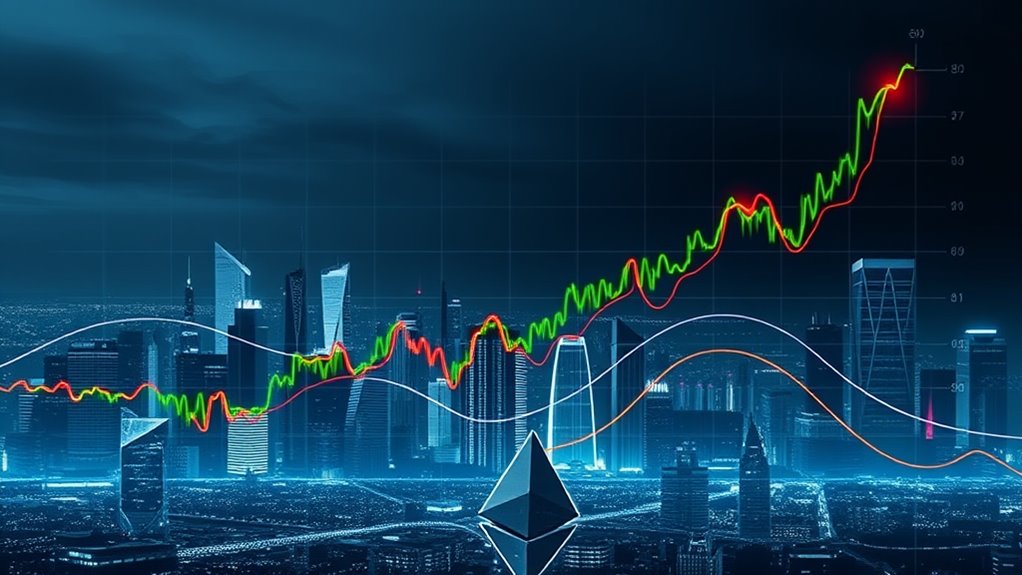
Ethereum Price History and Predictions: Understanding Trends and Future Outlook
Ethereum’s price history shows remarkable volatility since its 2015 launch at $2.92, reaching an all-time high of $4,783 in November 2021. Market makers, macroeconomic factors, and technological upgrades like EIP-1559 and The Merge greatly influence its value. Expert predictions for 2024-2025 range from $2,061 to $6,660, depending on regulatory developments, Layer 2 scaling solutions, and potential ETF approvals. Effective investment strategies incorporate market cycle analysis, diversification, and technical indicators to navigate Ethereum’s fluctuations.
Key Takeaways
- Ethereum grew from $2.92 in 2015 to an all-time high of $4,783 in November 2021, demonstrating significant long-term growth.
- Major technological upgrades like EIP-1559 and The Merge consistently drive price increases and improve Ethereum’s underlying value.
- Market volatility is influenced by Bitcoin correlation, institutional participation, and macroeconomic factors like inflation and monetary policies.
- Expert predictions for 2024-2025 range from $2,061 to $6,660, with Layer-2 scaling and potential ETF approvals as key growth drivers.
- Investment strategies should include understanding market cycles, diversification, technical analysis, and monitoring Ethereum’s ongoing development progress.
Ethereum’s Historical Price Journey: From $10 to All-Time Highs

Volatility has defined Ethereum’s remarkable price history since its 2015 launch. Beginning at approximately $2.92, ETH experienced significant fluctuations, dropping below $1 for months before crossing the $10 threshold in March 2016.
After a brief touch of $20 that June, prices retreated to close 2016 at roughly $8.
The cryptocurrency gained substantial momentum in 2017, surpassing $300 by mid-year as DeFi applications expanded. This growth accelerated dramatically in late 2017, with prices reaching nearly $1,000 in early January 2018.
However, a significant correction followed, with ETH falling below $400 by March and ending 2018 at just $133.
After several years of fluctuation, Ethereum achieved an all-time high of approximately $4,783 in November 2021, representing an extraordinary journey from its humble beginnings. As Ethereum continues to evolve with technological advancements like Ethereum 2.0, its potential for future price growth remains optimistic.
Key Drivers Behind Ethereum Price Volatility

Multiple factors contribute to Ethereum’s price volatility, creating a complex ecosystem where changes can occur rapidly and dramatically. Understanding these drivers helps investors navigate this unpredictable landscape.
Ethereum’s volatility stems from a complex interplay of factors that demand investor vigilance in this rapidly evolving market.
- Market Maker Dynamics – Professional traders amplify price movements through dynamic hedging strategies, especially during high volatility periods.
- Macroeconomic Influences – Inflation rates, monetary policies, and the strength of the U.S. dollar considerably impact Ethereum’s value and trading patterns.
- Bitcoin Correlation – Ethereum frequently mirrors Bitcoin’s price movements, making it susceptible to volatility in the broader cryptocurrency market.
- Institutional Participation – While providing stability through increased investment, institutional players can introduce new volatility factors when their trading strategies shift in response to market conditions. Additionally, the growing trend of institutional adoption is influencing Ethereum’s market dynamics and overall price stability.
The Impact of Technological Upgrades on ETH Value

Throughout Ethereum’s history, major technological upgrades have consistently demonstrated their ability to influence ETH’s market value, both in the short and long term. Significant updates like the London Update with EIP-1559 resulted in 30% price growth, while the shift to Proof-of-Stake during The Merge initially boosted prices before a decline followed.
The upcoming Pectra upgrade, combining Prague and Electra improvements, focuses on enhancing scalability and transaction efficiency through innovations like Verkle Trees and EVM Object Format. These technological advancements not only improve network operations but potentially affect investor sentiment and adoption rates. Additionally, the integration of Layer 2 solutions aims to further alleviate network congestion and enhance transaction speeds, which could positively impact ETH’s value.
While upgrades often create short-term price volatility, their long-term impact depends on successful implementation, actual performance improvements, and broader market conditions including institutional interest and macroeconomic factors.
Market Analysis: Expert Predictions for Ethereum in 2024-2025

As Ethereum continues to develop its technology and market presence, financial experts have released varying predictions for its performance in the 2024-2025 period.
Consensus indicates growth potential, though with considerable variance in price targets.
- Price forecasts for 2024 range from conservative estimates of $2,768-$3,374 (CoinPriceForecast) to more optimistic projections of €5,538 by year-end.
- 2025 predictions show wider variation, with prices between $2,061-$6,660 depending on institutional adoption and market conditions.
- Key growth factors include layer-2 scaling solutions, potential ETF approvals, and increased DeFi adoption.
- Regulatory developments and broader crypto market trends remain significant influences on Ethereum’s performance.
The shift from Proof of Work to Proof of Stake is expected to improve scalability, potentially supporting these growth projections. Additionally, the rise of DeFi protocols is likely to enhance Ethereum’s utility and attract more users to the ecosystem.
Investment Strategies for Navigating Ethereum’s Market Cycles

While expert predictions offer valuable insights into Ethereum’s potential future value, investors need practical strategies for maneuvering the cryptocurrency’s notorious market volatility.
Successful Ethereum investing typically involves understanding market cycles, including Bitcoin halving events that often influence the broader crypto market.
Diversification remains fundamental, with investors balancing Ethereum holdings against other assets to mitigate risk.
Technical indicators like moving averages and support/resistance levels help identify ideal entry and exit points, while on-chain metrics provide deeper insights into network health.
Position sizing based on individual risk tolerance prevents overexposure during downturns.
Regular portfolio rebalancing and implementing stop-loss orders further protect investments.
Many experienced investors combine these approaches with fundamental analysis of Ethereum’s technological developments, adoption rates, and regulatory landscape to make informed decisions throughout market cycles. Additionally, the transition to Proof of Stake has made Ethereum more energy-efficient, further influencing its long-term viability as an investment.
Frequently Asked Questions
How Do Ethereum Gas Fees Correlate With Price Movements?
Historically, low gas fees on Ethereum have often preceded price rebounds, as decreased transaction costs make the network more competitive. However, sustained low fees can also signal reduced network activity, potentially affecting prices negatively.
What Tax Implications Apply to Staking Ethereum Rewards?
Like precious gems awaiting appraisal, staking Ethereum rewards are subject to ordinary income tax at fair market value upon receipt. Rewards must be reported on Form 1040 Schedule 1, regardless of their dollar amount.
How Do Competitor Blockchain Failures Affect Ethereum’s Price?
Competitor blockchain failures often boost Ethereum’s price as investors seek refuge in established networks. These events can increase market confidence in Ethereum’s stability, driving capital inflow and enhancing its relative market position.
Can Ethereum Mining Equipment Be Repurposed After the Pos Transition?
Like phoenixes rising from ashes, Ethereum mining equipment can indeed be repurposed after PoS. Miners can shift to alternative cryptocurrencies, adapt for AI applications, gaming, data centers, or server functions depending on hardware specifications.
How Do Whale Wallet Movements Impact Short-Term Ethereum Prices?
Whale wallet movements greatly impact short-term Ethereum prices through market liquidity shifts. Large transfers to exchanges often signal selling pressure, while accumulation patterns typically provide price support and influence broader market sentiment.
Conclusion
Ethereum’s journey from modest beginnings to a financial powerhouse illustrates cryptocurrency’s dynamic nature. While technological advancements and market sentiment continue to influence its trajectory, investors should remember that ETH won’t always be the cat’s pajamas of the digital asset world. Developing a strategy based on market cycles, diversification, and technological understanding remains essential for those traversing Ethereum’s volatile yet potentially rewarding landscape.












